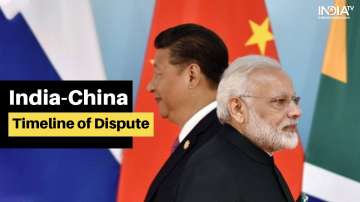India-China LAC Face-off: Timeline of all contention
Twenty Indian Army personnel including a colonel were killed in a fierce clash with Chinese troops in the Galwan Valley in eastern Ladakh on Monday night, the biggest military confrontation in over five decades that has significantly escalated the already volatile border standoff in the region.

Twenty Indian Army personnel including a colonel were killed in a fierce clash with Chinese troops in the Galwan Valley in eastern Ladakh on Monday night, the biggest military confrontation in over five decades that has significantly escalated the already volatile border standoff in the region. The Army initially said on Tuesday that an officer and two soldiers were killed. But in a late evening statement, it revised the figure to 20 saying 17 others who "were critically injured in the line of duty and exposed to sub-zero temperatures at the standoff location succumbed to their injuries."
Government sources said the Chinese side too suffered "proportionate casualties" but chose not to speculate on the number. It is the biggest confrontation between the two militaries after their 1967 clashes in Nathu La when India lost around 80 soldiers while over 300 Chinese army personnel were killed in the confrontation.
The casualties take both sides into uncharted territory at a time when the government’s attention is focused on fighting the COVID-19 crisis that appears to be ballooning by the day.
"Indian and Chinese troops have disengaged at the Galwan area where they had earlier clashed on the night of 15/16 June 2020,” the Army statement said.
Border tensions between the two countries have existed for over seven decades now
Here's a timeline of what has happened between the two countries since 1947
1947: A 1,200-km long road, connecting Xinjiang and western Tibet was constructed by China. One seventy-nine kilometer of the whole stretch ran south of the Johnson Line through the Aksai Chin region, which India claims as part of the union territory of Ladakh.
1960: Officials from India and China held discussions to settle the boundary dispute, based on an agreement between the then Prime Minister Jawaharlal Nehru and his Chinese counterpart Zhou Enlai.
1962: The boundary dispute escalated into the Sino-Indian War in October 1962, which led to nearly 3,000 causalities on the Indian side, while some 700 people lost their lives on the Chinese side.
1967: This year marked the beginning of the Nathu La and Cho La clashes, on September 11. The Chinese Army at this time had attacked an Indian post at Nathu La.
1975: Armies of India and China clashed at Tulung La, Tawang district of the northeastern state of Arunachal Pradesh, in which 4 Indian soldiers were killed.
1976: India and China agreed to resume appointing diplomats to the other nation after a gap of 15 years.
1986-87: Chinese troop presence in Arunachal Pradesh is met by the Indian Army's 'Operation Falcon'. The standoff had eased following negotiations.
1988: India and China had agreed to set up a joint working group on the boundary issues.
1993: Agreement signed on Maintenance of Peace and Tranquility along the Line of Actual Control, thus recognising the LAC.
1996: India and China signed an agreement on confidence-building measures along LAC.
1999: China built 5 km track right up to Pangong Tso's southern bank, amid the Kargil conflict with Pakistan.
2000: China built permanent roads and set up bunkers inside the Indian part of LAC in Ladakh's Aksai Chin area.
2013: Chinese troops intrude into Depsand Valley in Ladakh. The standoff was later resolved following negotiations. In October, the two sides signed the Border Defence Cooperation Agreement.
2014: Chinese soldiers attempted to build a road in the Chumar area of Ladakh. Prime Minister Narendra Modi later took up the matter with Chinese President Xi Jinping.
2017: Indian soldiers moved to prevent Chinese troops from building roads in the trijunction area of LAC near the Bhutan border. The standoff ended after the troops had withdrawn.
2020: Violent escalations occur in Ladakh's Galwan Valley amid senior military-level talks.
Also Read | Indian Army's official statement on LAC face-off with China